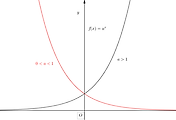함수의 극한
수학이야기/미적분 2014. 11. 28. 14:50함수의 극한은 수학에서 특정한 점에서 함숫값의 변화를 살펴보는 것으로 미적분이나 해석학을 공부할 때 기본이 되는 개념이다. 고등학교에서는 아래와 같은 초창기 정의로 다룬다.
함수 $ f(x)$에서 $x$가 $p$와 다른 값을 가지면서 $p$에 한없이 가까워질 때 $f(x)$의 값이 일정한 값 $L$에 한없이 가까워지면 $x\rightarrow p$일 때 $f(x)$는 $L$에 수렴한다고 하고 아래와 같이 나타낸다.
$x \rightarrow p$일 때 $f(x) \rightarrow L$ 또는 $ \displaystyle { \lim_{x \rightarrow p} f(x)=L }$
더욱 엄밀한 정의는 볼짜노(Bolzano) 가 제안한 $\varepsilon-\delta$ 를 써서 정의한다.
$\forall \varepsilon >0$에 대하여 다음을 만족하는 $ \delta >0$가 존재한다.
모든 실수 $x$에 대하여 $0<|x-p|<\delta \Rightarrow |f(x)-L|<\varepsilon$
보기
1. $f(x)=x$
$\forall \varepsilon>0$에 대하여 $\displaystyle{\delta=\frac{1}{2}\varepsilon}$이라고 하면
$0<|x-p|<\delta$인 $\forall x$에 대하여 $|f(x)-p|<\delta<\varepsilon$이다.
$\therefore\;\;\displaystyle{\lim_{x\rightarrow p}x=p}$
2. $f(x)=x^2 $
$\forall \varepsilon>0$에 대하여 $x$가 $p$에 충분히 가깝다면 $|x-p|<1$이라고 할 수 있다.
그러면 $|x| \leq |p|+1$이므로 $|x+p| \leq|x|+|p| \leq 2|p|+1$이다.
이제 $\displaystyle{\delta=min \bigg(1,\frac{\varepsilon}{2|p|+1}\bigg)}$이라고 하자.(단, $min(x,y)$는 $x,y$ 가운데 크지 않은 것)
$0<|x-p|<\delta$인 $\forall x$에 대하여1) $\displaystyle{1\leq \frac{\varepsilon}{2|p|+1}}$이라고 하면 $2|p|+1 \leq \varepsilon$이므로
$|f(x)-p^2 |=|x^2 -p^2|=|x-p||x+p|<|x-p|(2|p|+1)<2|p|+1 \leq \varepsilon$이다.
2) $\displaystyle{\frac{\varepsilon}{2|p|+1}<1}$이라고 하면
$|f(x)-p^2 |=|x^2 -p^2|=|x-p||x+p|<|x-p|(2|p|+1)<\varepsilon$이다.
$\therefore\;\;\displaystyle{\lim_{x\rightarrow p}x^2 =p^2}$
함수의 그래프가 아래와 같다면 $x=p$인 점에서 아무리 작게 $\delta$를 잡아도 정의를 만족할 수 없다. 이런 경우 발산한다고 한다.
 |
 |
하지만 $\displaystyle{f(x)=\sin\frac{1}{x}}$은 직관적으로 극한을 알기 어렵다. 그래프는 아래와 같다.
먼저 $x$축과 만나는 점을 찾아 보자.
$\displaystyle{\sin \frac{1}{x}=0}$에서 $\displaystyle{\frac{1}{x}=\pm n\pi}$이다.
$\therefore\;\;\displaystyle{x=\pm \frac{1}{n\pi}}$
$y=1$이라고 하면 $\displaystyle{\sin \frac{1}{x}=1}$에서 $\displaystyle{\frac{1}{x}=2n\pi +\frac{\pi}{2}}$이다.
$\therefore\;\;\displaystyle{x= \frac{2}{(4n+1)\pi}}$
$y=-1$이라고 하면 $\displaystyle{\sin \frac{1}{x}=-1}$에서 $\displaystyle{\frac{1}{x}=2n\pi+\frac{3\pi}{2}}$이다.
$\therefore\;\;\displaystyle{x= \frac{2}{(4n+3)\pi}}$
단, $n\in \mathbb{Z}$이다.
$x=0$에서 함숫값을 정의할 수 없고, $x=0$ 가까운 곳에서는 아주 빠르게 진동하고 있다. 이런 함수의 극한은 아래와 같은 정리를 써서 극한을 알아 볼 수 있다.
정리 $\displaystyle{\lim_{x\rightarrow p}f(x)=L}$이라면 $p$로 수렴하는 모든 수열 $\{x_n \}$에 대하여 수열 $\{f(x_n)\}$은 모두 $L$로 수렴한다.
즉, $\forall x_n \rightarrow p \Rightarrow f(x_n) \rightarrow L$이다. 역도 성립한다.
위에 주어진 함수에서 $\displaystyle{x_n = \frac{2}{(4n+1)\pi} \;\;(n \in \mathbb{N})}$이라고 하면 $n \rightarrow \infty$일 때, $x_n \rightarrow 0$이고 $f(x_n) \rightarrow 1$이다.
한편, $\displaystyle{x_n =\frac{2}{(4n+3) \pi} \;\; (n \in \mathbb{N})}$이라고 하면 $n\rightarrow \infty$일 때, $x_n \rightarrow 0$이고 $f(x_n)\rightarrow -1$이다.
$\therefore \;\;x\rightarrow 0$일 때, $\displaystyle{f(x)=\sin \frac{1}{x}}$은 발산한다.








